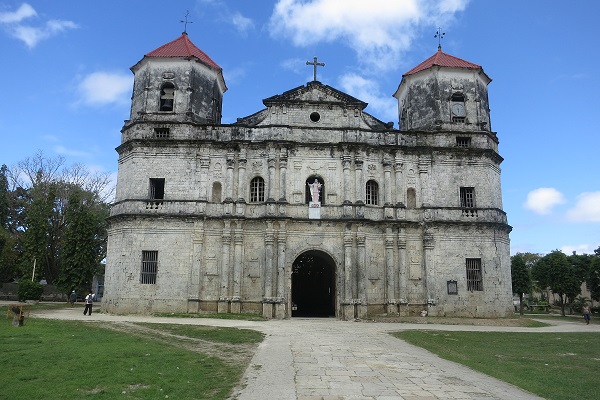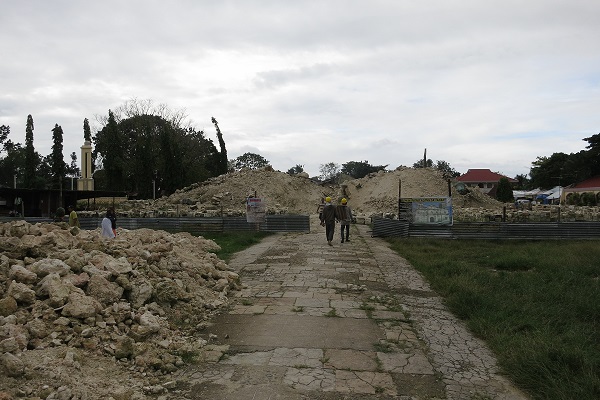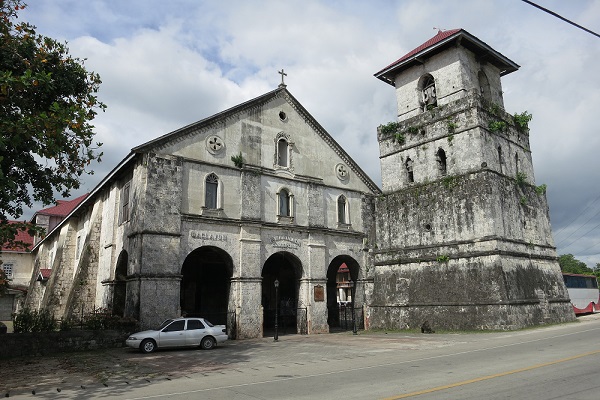Roz Li calls for scientific approach to restoring Bohol’s historic churches

Before the earthquake: Loon Church, built in 1853, is a designated National Cultural Treasure and a National Historical Landmark. Photo by Roz Li

After the earthquake: Loon Church is one of two churches which totally collapsed. Not one wall was left standing. Photo by Roz Li.
“The Philippine government has made a commitment to restore and reconstruct the historically significant churches of Bohol,” said Roz Li, president of Bakás Pilipinas, Inc., a New York-based non-profit dedicated to the preservation of historic architecture and sites in the Philippines. “Funds for restoration have reportedly been budgeted over a period of three to five years.”
The earthquake-damaged coral stone churches of Bohol was the topic of a presentation by Roz on April 17 at Columbia University’s Inquiry: HP Lecture Series, at the Historic Preservation Program. Her talk presented photographs of several historic churches in Bohol, taken before and after the earthquake. The churches, she said, date from the 18th through the 20th centuries, all constructed with dressed coral stone facing on the exterior and interior faces of thick load-bearing walls, with rubble infill in between.
The earthquake occurred along a newly discovered fault on the island, which ruptured an area close to the west coast of the island of Bohol. Roz said Bohol gained around 500 meters more shoreline and shifted 55 centimeters west towards Cebu as a result of the powerful tremor.
“The earthquake struck during a public holiday, which helped reduce the number of casualties,” she said.
The ancient churches that were damaged by the quake included those in Baclayon (built in 1727), Loay (1815), Cortes (1887-1896), Dauis (begun in 1863 and completed in 1923), Loboc (1734), and Albuquerque (1885). The churches in Loon (1853) and Maribojoc (1852-1872), were literally “pulverized,” without a wall left standing.
Six hours after the earthquake, a Heritage Task Force was convened to assess the damage, she said. This task force consisted of representatives of the National Museum, the National Commission on Culture and the Arts, the National Historical Commission of the Philippines, and the Diocese of Tagbilaran, Bohol, who are the owners of the churches.
Several weeks later, an international team of experts was sent by UNESCO, in collaboration with ICCROM, the Rome-based International Centre for the Study of Restoration of Cultural Property. The UNESCO team offered a number of recommendations that include documenting and stabilizing materials retrieved from the churches and carrying out a comprehensive risk assessment study with the involvement of structural engineers, specialized emergency first responders, object conservators, experts and stakeholders.
“The UNESCO team did a remarkable damage report assessment within a very short site visit,” said Roz.
After the presentation, discussion among the Columbia graduate students and preservation professionals focused on the lack of proper maintenance typical of the Philippines’ historic churches.
Said Roz, “If you visit any old church throughout the Philippines, you will see plants growing out of church towers. Most people think that is how it should be because it is old. But those plants are there because it means there is moisture in the walls and the plant roots actually exert force and destroy the stones or bricks.”
She continued: “Most building problems are caused by water penetration through roof leaks, improper roof flashings, lack of gutters and leaders, and open stone mortar joints. Good maintenance practice involves periodic inspection of the buildings and addressing these problems before they cause serious damage.”
There is also some evidence that these coral stone churches may have been originally coated on the exterior with limewash, which served to protect the mortar in stone joints from washing out. She explained, “Mortar is essential to the structural integrity of the stone walls. Repointing of open stone joints and periodic recoating with limewash, if original to the building, are necessary parts of any maintenance program.”
“I was told that during Imelda Marcos’ time, her favorite architect took off the coatings from a lot of historic buildings, so that they will look more ‘picturesque.’ That caused the deterioration of many church facades. When the church stewards realized that it was a mistake, they re-applied coatings to the facades, but they did not know the right type of coating (right ingredients). They used cement, which does not ‘breathe.’ That caused even more serious damage to the facades,” she explained fully.
It was a tragedy of “mistakes upon mistakes,” she added, which is why conservators and other experts are pushing for a more scientific approach to restoration.
Aside from restoration, members of Bakás Pilipinas are also concerned about the still-intact historic churches throughout the Philippines and their ability to withstand future earthquakes and other natural calamities. One of the projects the group thinks may be worth initiating is an “Adopt-a-Historic-Building” type of campaign, where Filipino American groups can adopt their town churches and support their maintenance, but always under the guidance of preservation professionals.
“I cannot overemphasize how important periodic maintenance is in preserving historic structures,” she said. “But it is often not done in the Philippines. Until it falls apart, nothing is done. Maintenance is not ‘sexy.’ Nobody wants to pay for it. Even here in the United States, owners balk at maintenance work.”













